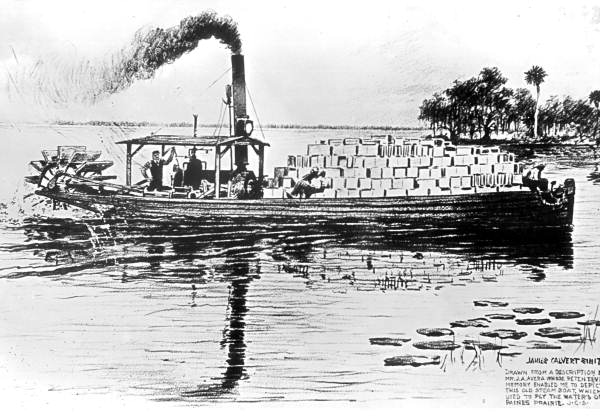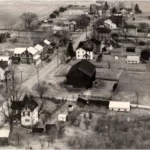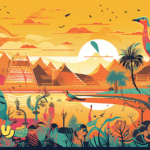Hey there, nature and history enthusiasts! Prepare to be captivated by the remarkable world of Paynes Prairie, a Florida gem teeming with beauty, wildlife, and a rich past. From its ancient origins as a sprawling lake to its transformation into a vibrant prairie, Paynes Prairie has played a pivotal role in shaping Florida’s identity. Join us as we delve into the mysteries of this natural and cultural treasure.
History of Paynes Prairie
Paynes Prairie, a place brimming with life today, harbors a past as rich and deep as the sinkholes that dot its landscape. Imagine, over 15,000 years ago, Native Americans already called this place home, fishing its waters and hunting its abundant game – a testament to the prairie’s bounty.
Centuries later, the Alachua Seminole, led by Chief Ahaya, established a strong presence on the prairie, building villages like Cuscowilla and Paynes Town. However, as with everything in nature, the prairie was ever-changing. In the 1800s, a shift in water flow dramatically altered the landscape. A blocked sinkhole caused the prairie to flood, giving rise to Alachua Lake. This newly formed lake became a bustling route for steamboats, connecting the region in unprecedented ways. Eventually, the waters receded, and Paynes Prairie returned to its previous form, forever changed by its time as a lake.
This remarkable place also witnessed history unfold. Paynes Town met a tragic end during the War of 1812, while the Second Seminole War left its mark with forts like Tarver and Crane standing as silent sentinels. As the 1800s drew to a close, the arrival of railroads connected Paynes Prairie to a rapidly modernizing world.
Recognizing its incredible ecological and historical significance, the state of Florida acquired Paynes Prairie in 1970 and designated it as a state preserve a year later, ensuring its protection for generations to come.
What is Paynes Prairie Known For?
Paynes Prairie is no ordinary park. Established in 1970 as Florida’s very first state preserve, it stands as a testament to the state’s commitment to protecting its natural heritage. Its designation as a National Natural Landmark further underscores its unique ecological significance.
What makes Paynes Prairie so special? Imagine a tapestry of marshes, prairies, and watering holes, all teeming with life. Birdwatchers will be enthralled by the over 300 bird species that grace the prairie, including majestic Sandhill cranes, elegant egrets, and soaring hawks.
Beneath the surface, Paynes Prairie holds ancient secrets. Sinkholes and shifting landscapes have sculpted a terrain that provides refuge for rare and endangered species. This ever-changing environment, shaped by both geological forces and human history, is a testament to nature’s resilience.
Paynes Prairie is also a living timeline of human history. From the Native Americans who first called this area home to the Spanish ranchers who herded cattle across its expanse in the 17th century, each chapter of human presence has left an indelible mark. The echoes of the Second Seminole War, with its forts and military outposts, still resonate, while the arrival of railroads in the late 1800s marked the dawn of a new era.
Visiting Paynes Prairie is an opportunity to step back in time while being surrounded by the wonders of the natural world. It’s a place where you can escape the hustle and bustle of daily life and reconnect with something larger than yourself.
Did Paynes Prairie used to be a lake?
Indeed, it did! The Paynes Prairie we know today was once submerged beneath a vast lake known as Alachua Lake. In the 1870s, a blockage in the Alachua Sink, the area’s natural drain, caused water levels to rise dramatically, transforming the prairie into a lake. For approximately two decades, Alachua Lake thrived, even supporting steamboat traffic.
However, like all things in nature, this state was not permanent. Human intervention in the form of canals and other water management practices, coupled with natural processes, gradually led to the lake’s demise. As the waters receded, Paynes Prairie reemerged, its landscape forever altered by its time submerged.
Even today, Paynes Prairie offers glimpses into its watery past. Heavy rainfall can lead to temporary flooding, transforming the prairie into a fleeting echo of Alachua Lake. This cyclical interplay between prairie and lake highlights the dynamic nature of this remarkable ecosystem.
How did bison get to Paynes Prairie?
The story of how bison, those iconic symbols of the American West, found their way to Paynes Prairie is a testament to conservation efforts. Once native to Florida, bison populations were decimated by overhunting and habitat loss. However, in 1975, the Real Florida Initiative, a group dedicated to restoring the state’s natural heritage, embarked on a mission to reintroduce these magnificent creatures to their former habitat.
Ten bison were brought from Nebraska to Paynes Prairie, marking the beginning of a successful reintroduction program. Today, the prairie boasts a thriving herd of 50 to 70 bison, their presence a testament to the power of conservation.
Living Alongside Giants: Managing the Herd
The presence of large, powerful animals like bison in close proximity to human populations necessitates careful management. To prevent potential conflicts, park rangers closely monitor the herd and, if necessary, relocate bison that exhibit aggressive behavior. This delicate balance ensures the safety of both humans and these magnificent creatures.
More Than Just a Pretty Face: Bison as Ecosystem Engineers
Bison play a crucial role in maintaining the health and diversity of the prairie ecosystem. Their grazing habits create open spaces in the vegetation, allowing a greater variety of plants to thrive. Their hooves churn the soil, promoting nutrient cycling, and their droppings act as natural fertilizer. In essence, these gentle giants are vital ecosystem engineers, shaping and maintaining the prairie’s delicate balance.
Key Takeaways:
- Bison: From Florida Native to Reintroduced Species: Once native to Florida, bison were wiped out due to human activities. Reintroduction efforts have successfully brought them back to Paynes Prairie.
- Real Florida Initiative: The Heroes of the Story: This dedicated group spearheaded the effort to restore bison to Florida’s savannas.
- Paynes Prairie: Home to a Thriving Bison Herd: The prairie now supports a healthy bison population, with numbers fluctuating between 50 and 70 individuals.
- Balancing Act: Managing Bison and Human Interaction: Park officials carefully monitor the herd and take steps to mitigate potential conflicts between bison and nearby communities.
- Nature’s Landscapers: The Ecological Importance of Bison: Bison grazing plays a vital role in maintaining a healthy and diverse prairie ecosystem.
Who owns Paynes Prairie?
Paynes Prairie Preserve State Park, encompassing a sprawling 21,000 acres, stands as a testament to Florida’s commitment to conservation. But who owns this vast and vibrant ecosystem?
The story of Paynes Prairie’s ownership is a journey through time, spanning centuries. In the 17th century, it was part of the La Chua ranch, a sprawling estate. Over time, ownership shifted, with Native American tribes, European settlers, and finally, the state of Florida playing significant roles.
Today, the Florida Department of Environmental Protection (DEP) manages and protects Paynes Prairie. They are the stewards of this ecological treasure, responsible for safeguarding its diverse plant and animal life and preserving its cultural and historical sites.
In essence:
- Paynes Prairie Preserve State Park belongs to the people of Florida.
- The Florida DEP is entrusted with the park’s care and management.
- The prairie’s ownership journey reflects a rich tapestry of Native American stewardship, European settlement, and ultimately, state guardianship
Are there alligators in Paynes Prairie?
Absolutely! Paynes Prairie is home to a thriving alligator population. The La Chua Trail, leading to the Alachua Sink, offers prime viewing opportunities. Visitors are likely to encounter numerous alligators basking in the sun, a testament to the prairie’s healthy ecosystem.
While alligators are fascinating creatures, it’s crucial to remember that they are wild animals that deserve respect and distance. Adhering to park guidelines and observing alligators from a safe distance ensures both visitor safety and the well-being of these prehistoric reptiles.
Paynes Prairie’s wildlife diversity extends far beyond alligators. Bison and wild horses roam freely, while over 300 bird species grace the skies. It’s a true testament to the prairie’s ecological richness.
Key Points:
- Paynes Prairie supports a abundant alligator population, particularly around the La Chua Trail and Alachua Sink.
- Always view alligators from a distance and follow park regulations to ensure safety.
- Paynes Prairie is teeming with a wide array of other wildlife, making it a prime destination for nature enthusiasts.
How Deep is the Alachua Sink?
The Alachua Sink, a National Natural Landmark, plunges to an astounding depth of 227 feet, making it one of the most impressive sinkholes in Florida. This geological wonder serves as a vital conduit, channeling water into the Floridan Aquifer, the primary source of drinking water for much of the state.
Concealed within the sinkhole’s depths lies a miniature rainforest, a testament to nature’s ability to thrive in unexpected places. Since the 1880s, visitors have been drawn to this unique ecosystem, characterized by its tannic-stained water and the interplay of light and shadow.
This underwater world teems with life, from soft-shelled turtles and alligators to a variety of fish and cave-dwelling crustaceans. Many of these species are classified as “species of special concern” by the State of Florida, underscoring the importance of protecting this delicate ecosystem.
The Alachua Sink is more than just a deep hole; it’s a vital source of water, a refuge for unique life forms, and a reminder that extraordinary discoveries often lie hidden beneath the surface.
What is prairie known for?
Prairies, those seemingly endless grasslands that define the heart of North America, are often overlooked but incredibly important ecosystems. Their rich, fertile soil and favorable climate have made them the cornerstone of agriculture, producing a significant portion of the world’s food supply.
Beyond their agricultural importance, prairies are bustling hubs of life. Iconic animals like bison and prairie dogs, along with countless bird species, depend on these grasslands for survival. This intricate web of life highlights the ecological significance of prairies.
The vast expanse of prairies is largely due to the rain shadow effect of the Rocky Mountains, which creates a drier climate that favors grasses over trees. However, these vital ecosystems are under threat from habitat loss due to human activities.
Conservation efforts are crucial to protecting what remains of these valuable landscapes. Prairies provide essential ecosystem services, including cleaning our air, filtering water, and supporting biodiversity. By understanding and appreciating the importance of prairies, we can work towards a future where these vital ecosystems continue to thrive.
Do You Have to Pay to Get into Paynes Prairie?
Good news! Access to Paynes Prairie Preserve State Park is free for pedestrians, cyclists, and those carpooling with friends. However, there are nominal fees for vehicles entering the park: $6 for vehicles with 2-8 people and $4 for single-occupant vehicles.
Additional fees apply for specific trails:
- La Chua Trail: $4 per vehicle
- Bolen Bluff Trail: $2 per vehicle
These fees help maintain the park and its facilities, ensuring its accessibility for future generations. It’s always advisable to check the official Florida State Parks website for the most up-to-date fee information.
Remember, Paynes Prairie is open from sunrise to sunset, 365 days a year, offering ample opportunity to experience its beauty.
What Animals are in Paynes Prairie?
Paynes Prairie Preserve State Park is a haven for wildlife enthusiasts, boasting an impressive diversity of species. Its blend of habitats – marshes, prairies, waterways – provides a home for an array of creatures, making it feel like a living, breathing nature documentary.
Birdwatchers will be in awe of the over 300 bird species recorded in the park, including the captivating sandhill crane with its elaborate courtship dances, elegant egrets wading gracefully in the water, and hawks soaring effortlessly overhead.
Paynes Prairie’s wetlands teem with alligators, offering a glimpse into a prehistoric past. These magnificent reptiles, though fascinating to observe, command respect and a safe distance.
The park’s reintroduction of bison and wild horses has been a resounding success. Herds of these magnificent creatures roaming freely across the prairie are a sight to behold, showcasing a return to a more natural state.
Beyond these charismatic megafauna, Paynes Prairie is home to white-tailed deer, bobcats, coyotes, and a plethora of smaller creatures that contribute to the symphony of life. From the rhythmic drumming of woodpeckers to the melodic calls of songbirds, the park is alive with sights and sounds that will captivate any nature enthusiast.
What is the Black Prairie Known For?
The Black Prairie, a unique region straddling the border of Alabama and Mississippi, derives its name from its rich, dark soil composed of decomposed limestone. This fertile ground nurtures a diverse mix of plant and animal life, including species typically found in the Great Plains.
The Black Prairie is a fascinating mosaic of habitats, with open grasslands interspersed with chalky outcrops and pockets of lush forests. This ecological diversity is a testament to the region’s unique geology and evolutionary history.
Sadly, much of the original Black Prairie has been lost to agriculture and development. However, there is growing recognition of the ecological and historical importance of this unique region. Conservation efforts are underway to protect what remains and restore some of what’s been lost. These initiatives highlight the importance of preserving Earth’s diverse ecosystems.
This concludes our exploration of Paynes Prairie and its fascinating history. We hope you’ve enjoyed this journey and feel inspired to experience the wonder of this natural treasure for yourself!
Don’t forget to explore these related articles:
Delve into the intricate legacy of Papel Picado, the iconic Mexican paper art steeped in vibrant history: history of papel picado.
Embark on a culinary adventure and uncover the captivating origins of Patatas Bravas, a delectable Spanish dish with a rich heritage: history of patatas bravas.
- Discover Trasa Robertson Cobern’s Mentors: Shaping Her Hurst Campaign - July 9, 2025
- Discover People Influenced by Trasa Cobern: A Legacy of Service - July 9, 2025
- Discover Trasa Cobern’s Nonprofit Impact: A Deep Dive - July 7, 2025

















1 thought on “Unveiling the Timeless Story: A Journey Through the History of Paynes Prairie”
Comments are closed.